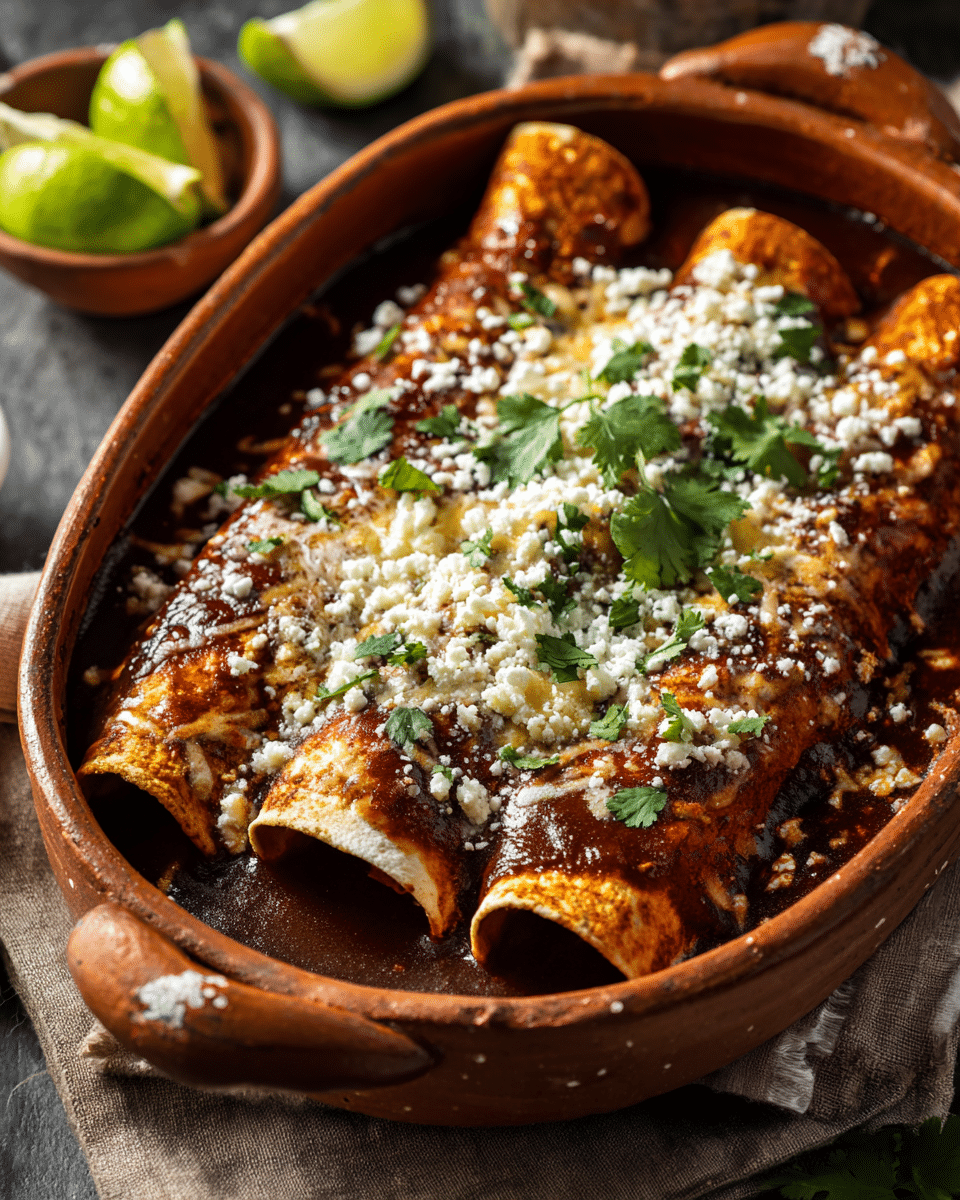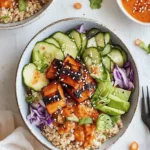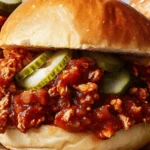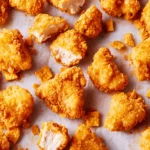Mole enchiladas are a beloved Mexican dish that combines tender corn tortillas filled with savory shredded chicken and smothered in rich, velvety mole sauce. Mole, a traditional sauce with roots in pre-Hispanic and colonial Mexican cuisine, is a complex blend of chili peppers, spices, nuts, seeds, and a hint of chocolate for depth.
FULL RECIPE
Ingredients
- 12 corn tortillas
- 3 cups cooked shredded chicken (or substitute with shredded turkey)
- 3 cups mole sauce (store-bought or homemade)
- 1 cup chicken broth (to thin the mole if needed)
- 1 cup crumbled queso fresco (or cotija cheese)
- ½ cup diced white onion
- ½ cup chopped fresh cilantro
- ½ cup sour cream or Mexican crema
- 2 tablespoons vegetable oil (for softening tortillas)
- Salt and pepper to taste
- Optional garnish: sesame seeds, avocado slices, radish slices
Directions
- In a large skillet, warm the mole sauce over medium heat. Add chicken broth gradually if the sauce is too thick, stirring until smooth and heated through.
- In a separate pan, heat vegetable oil over medium heat. Lightly fry each tortilla for about 10–15 seconds per side until softened, then place them on paper towels to drain excess oil.
- Dip each tortilla briefly into the warm mole sauce, coating both sides.
- Place about ¼ cup of shredded chicken in the center of each tortilla, then roll it up tightly.
- Arrange the rolled enchiladas seam-side down in a large baking dish or serving platter.
- Pour the remaining mole sauce generously over the enchiladas, making sure they’re fully covered.
- Sprinkle with crumbled queso fresco, diced onions, and fresh cilantro.
- Drizzle with sour cream or Mexican crema for added richness.
- Garnish with sesame seeds, avocado slices, or radish slices if desired.
- Serve warm with a side of Mexican rice and refried beans for a complete meal.
Nutrition Facts
- Calories: 420
- Protein: 26g
- Fat: 20g
- Saturated Fat: 7g
- Carbohydrates: 35g
- Fiber: 5g
- Sugars: 7g
- Sodium: 670mg
- Cholesterol: 75mg
Cultural Significance of Mole Enchiladas
Mole enchiladas hold a special place in Mexican culinary tradition, particularly during festive occasions such as Mexican Independence Day. The mole sauce itself is considered a labor of love, with roots tracing back to pre-Hispanic and colonial times when indigenous and Spanish ingredients first blended. Serving mole enchiladas during national celebrations is a way to honor cultural heritage and share the rich history of Mexico through food. The combination of mole’s deep, earthy flavor and the comforting texture of enchiladas reflects the fusion of cultures that shaped Mexican cuisine over centuries.
Flavor Profile and Texture
The allure of mole enchiladas lies in their complex and harmonious flavor profile. Mole sauce is famously layered, often blending chilies, nuts, seeds, spices, and a touch of chocolate to achieve a balance of savory, sweet, smoky, and slightly bitter notes. When paired with tender corn tortillas and juicy shredded chicken or turkey, the result is a melt-in-your-mouth experience. The toppings—crumbled cheese, onions, and fresh cilantro—add bursts of freshness and texture, creating a contrast that keeps each bite exciting.
Nutritional Benefits
While mole enchiladas are indulgent, they also offer certain nutritional benefits, particularly when made with lean proteins like chicken or turkey. The use of nuts and seeds in mole sauce contributes healthy fats, plant-based protein, and essential minerals such as magnesium and zinc. Corn tortillas provide dietary fiber, especially if made from whole corn masa. The inclusion of fresh herbs and vegetables adds antioxidants and vitamins, making the dish both flavorful and nutrient-rich when enjoyed in moderation.
Popular Variations
There are countless variations of mole enchiladas across Mexico, each with unique regional twists. For example, Mole Poblano, a dark and chocolate-rich version, is famous in Puebla, while Mole Coloradito from Oaxaca features a slightly sweeter and lighter red hue. Some versions replace chicken with pork, beef, or even vegetables for a vegetarian-friendly alternative. A creative spin for modern palates includes stuffing the tortillas with roasted sweet potatoes or black beans, catering to plant-based diets without compromising on flavor.
Serving Suggestions
Mole enchiladas are often served as part of a larger celebratory meal, accompanied by sides like Mexican rice, refried beans, or sautéed vegetables. Fresh toppings such as sliced avocado, radishes, or pickled jalapeños can add brightness and acidity to balance the richness of the mole. For special occasions, serving them on a large platter garnished with sesame seeds makes for a stunning presentation. A refreshing salad with citrus dressing can also act as a palate cleanser alongside the hearty dish.
Beverage Pairings
Choosing the right beverage can elevate the dining experience when enjoying mole enchiladas. Traditional pairings include aguas frescas like horchata, tamarind, or hibiscus tea, which provide a refreshing counterpoint to the sauce’s depth. For those who prefer alcoholic options, a smooth Mexican lager, a light-bodied red wine, or even a mezcal cocktail can complement the smoky and spicy notes of the mole. The key is to choose a drink that won’t overpower the complex flavors of the dish.
Tips for Making the Perfect Mole Sauce
Crafting mole sauce from scratch can be time-intensive, but the results are worth it. Roasting and toasting each ingredient individually before blending helps develop deep, layered flavors. Using a combination of dried chilies, such as ancho, pasilla, and mulato, creates a robust base, while the addition of nuts, seeds, and spices provides complexity. Balancing sweetness with savory notes, often by adding just the right amount of chocolate, ensures that the sauce is rich without being overly sweet.
Storage and Reheating Advice
Mole enchiladas can be prepared ahead of time, making them ideal for gatherings. Once assembled, they can be stored in an airtight container in the refrigerator for up to three days. For longer storage, freeze the enchiladas and sauce separately for up to two months. When reheating, gently warm the mole sauce over low heat and reheat the enchiladas in the oven to prevent the tortillas from becoming soggy. Adding fresh garnishes just before serving revives the dish’s vibrant appeal.
Healthier Preparation Alternatives
For a lighter take on mole enchiladas, opt for baking the tortillas instead of frying to reduce oil content. Using low-fat cheese or skipping it entirely can further lower saturated fat levels. Lean proteins like skinless chicken breast, turkey, or plant-based alternatives keep the dish satisfying without excessive calories. Mole sauce can also be made with reduced amounts of oil and chocolate while increasing the ratio of vegetables and herbs to maintain flavor with fewer calories.
Regional and Festive Presentation Styles
Presentation plays a significant role in how mole enchiladas are enjoyed during holidays. In Puebla, the dish is often adorned with sesame seeds and accompanied by colorful garnishes to reflect the festive spirit. During Mexican Independence Day, chefs may incorporate green, white, and red elements—like cilantro, crema, and diced tomatoes—to symbolize the national flag. Serving them in clay dishes or traditional cazuelas adds an authentic touch and helps retain heat for longer enjoyment.
Conclusion
Mole enchiladas are far more than just a delicious dinner option they are a culinary celebration of Mexico’s history, culture, and artistry. From the rich complexity of the mole sauce to the comforting embrace of soft tortillas, each element tells a story of tradition and regional pride. Whether enjoyed during a holiday feast or as a special family meal, mole enchiladas offer a sensory journey that delights the palate and honors the flavors of Mexico.






